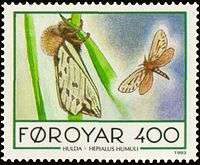Ghost moth
| Ghost moth | |
|---|---|
 | |
.png) | |
| Scientific classification | |
| Kingdom: | Animalia |
| Phylum: | Arthropoda |
| Class: | Insecta |
| Order: | Lepidoptera |
| Family: | Hepialidae |
| Genus: | Hepialus Fabricius, 1775 |
| Species: | H. humuli |
| Binomial name | |
| Hepialus humuli (Linnaeus, 1758) | |
| Synonyms | |
|
Genus:
Species:
| |
The ghost moth (Hepialus humuli), also known as the ghost swift, is a moth of the family Hepialidae. It is common throughout Europe except for the far south-east. This species is often considered the only species in the genus Hepialus and a number of previously included species is now reclassified into other genera. However, other authorities retain a number of species in the Hepialus genus.
The male has a wingspan of about 44 mm and both forewings and hindwings are pure white (although in H. h. thulensis, found in Shetland and the Faroe Islands, there are buff-coloured individuals). The female is larger (wingspan about 48 mm) and has yellowish-buff forewings with darker linear markings and brown hindwings. The adults fly from June to August and are attracted to light. The species overwinters as a larva.
The ghost moth gets its name from the display flight of the male, which hovers, sometimes slowly rising and falling, over open ground to attract females. In a suitable location several males may display together in a lek.
The larva is whitish and maggot-like and feeds underground on the roots of a variety of wild and cultivated plants (see list below). The species can be an economically significant pest in forest nurseries.
The term ghost moth is sometimes used as a general term for all Hepialids.
Subspecies
- Hepialus humuli humuli
- Hepialus humuli thulensis Newman, 1865 (Great Britain, Faroe Islands)
Recorded food plants
|
Additional species which may be included in Hepialus
Chinese authors retain a number of species in Hepialus. Most of these are placed in the genus Thitarodes by others. Species retained in Hepialus include:
|
|
Species previously included in the genus Hepialus
Species previously placed in the genus Hepialus include:
|
|
Gallery
 Ghost moth on a Faroese stamp
Ghost moth on a Faroese stamp Female
Female Male
Male
References
- Chinery, Michael: Collins Guide to the Insects of Britain and Western Europe, 1986 (Reprinted 1991)
- Skinner, Bernard: Colour Identification Guide to Moths of the British Isles, 1984
External links
| Wikimedia Commons has media related to Hepialus humuli. |
| Wikispecies has information related to: Hepialus |